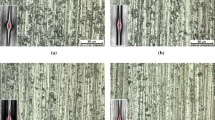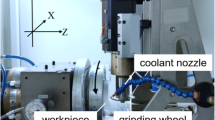Abstract
This paper presents a predictive model of subsurface damage depth hSSD and surface roughness in semi-consolidated abrasive grinding based on indentation fracture theory to rapidly and non-destructively detect subsurface damage of the workpiece. To verify the accuracy of the proposed model, cross-sectional microscopy was used to detect subsurface damage along the (100) and (010) crystal lographic planes in grinding of gallium oxide. In addition, the effects of grinding method, abrasive particle size, grinding pressure, and grinding disc speed on the damage along the (100) and (010) planes were analyzed. The results show a nonlinear relationship between the depth of the gallium oxide subsurface damage and surface roughness generated by semi-consolidated abrasive grinding. Under the same grinding conditions, the damage layer depth in semi-consolidated abrasive grinding is lower than in free abrasive grinding. When the same grinding method is used, the subsurface damage depth is greater along the (100) plane than along the (010) plane under the same grinding conditions. When the abrasive particle size is decreased from W14 to W3, the depth of the subsurface damage layer is reduced by 30% in semi-consolidated abrasive grinding. Reducing the grinding pressure can reduce the amount of subsurface damage, and the speed of the grinding disc also affects the subsurface damage of gallium oxide. The subsurface damage depth has little effect. After optimizing the grinding parameters, the surface roughness of gallium oxide along the (100) and (010) planes was 23 nm and 12 nm, respectively, and hSSD was 2.9 μm and 2.1 μm, respectively. The proposed model of the relationship between subsurface damage depth and surface roughness can be used to achieve rapid, accurate, and non-destructive detection of the depth of subsurface damage and provides technical guidance for subsequent grinding and polishing processes.














Similar content being viewed by others
Availability of data and material
The data that support the findings of this study are available from the corresponding author upon reasonable request.
Code availability
Not applicable.
References
Gao Sh, Li HG, Kang RK, He YW, Zhu XL (2021) Recent advance in preparation and ultra-precision machining of new generation semiconductor material of β-Ga2O3 single crystals. Chin J Mech Eng 57(09):213–232
Mu WX, Jia ZT, Yin YR, Hu QQ, Li Y, Wu BY, Zhang J, Tao XT (2017) High quality crystal growth and anisotropic physical characterization of β-Ga2O3, single crystals grown by EFG method. J Alloy Compd 714:453–458
Chen BL, Yang YF, Leng GQ, Huang ZH, Sun Z, Tao TY (2021) Research progress of preparation technology of β-Ga2O3 single crystal. Funct Mater 52(01):1070–1077
Mu WX, Yin YR, Jia ZT, Wang LJ, Sun J, Wang MX, Tang C, Hu QQ, Gao ZL, Zhang J, Lin N, Veronesi S, Wang ZP, Zhao X, Tao XT (2017) An extended application of β-Ga2O3 single crystals to the laser field: Cr4+: β-Ga2O3 utilized as a new promising saturable absorber. RSC Adv 7(35):21815–21819
Liu Y, Li ZH (2017) Adsorption and decomposition mechanism of formic acid on the Ga2O3 surface by first principle studies. Surf Sci 656:86–95
Kaur D, Kumar M (2021) A strategic review on gallium oxide based deep‐ultraviolet photodetectors: recent progress and future prospects. Adv Opt Mater 9(9)
Gao S, Wu Y, Kang RK, Huang H (2018) Nano grinding induced surface and deformation mechanism of single crystal beta-Ga2O3. Mat Sci Semicon 79:165–170
Feng LG, Li YF, Su XL, Wang S, Liu H, Wang JT, Gong ZN, Ding W, Zhang Y, Yun F (2016) Growth and characterization of spindle-like Ga2O3, nanocrystals by electrochemical reaction in hydrofluoric solution. Appl Surf Sci 389:205–210
Zhang CY, Dong ZG, Yuan S, Guo XG; Kang RK, Guo DM (2021) Study on subsurface damage mechanism of gallium nitride in nano-grinding. Mater Sci Semicond Process 128
Wang HD, Jiang WF, Peng GJ, Zhang TH (2020) Detection of subsurface damage depth of optical glass via chemical etching technology. Surf Tech 49(11):326–333
Yu W, Lv X (2008) Research on semi bonded abrasive lapping of CLBO crystal. Aviation Precis Manuf Tech 44(06):15-16+24
Wang WS (2020) Design, Preparation and processing mechanism research of patterned gel lapping plate for sapphire. Huaqiao Univ
Lin YC (2019) Research on preparation and properties of gel polishing pad in sodium alginate system. Huaqiao Univ
Zhu NN (2017) Mechanism and process research of lithium niobate lapping and polishing by fixed abrasive pad with a high efficiency and low dam age. Nanjing Univ Aeronaut Astronaut
Wang D, Zhang YX, Gao W, Yang LL, Su JX (2014) Study on the subsurface damage depth of the lapped SiC wafers. J Synthetic Cryst 43(06):1500-1503+1508
Hou J, Wang HX, Wang C, Wang JH, Zhu BW (2018) Nondestructive fluorescence detection method for subsurface damage depth of optics. J Harbin Inst Technol 50(07):17–22
Yang MH, Zhao YA, Yi K, Shao JD (2012) Subsurface damage characterization of ground fused silica by HF etching combined with polishing layer by layer. Chin J Las 39(03):94–99
Wang J, Zheng FF, Dong ZG, Kang RK, Liu JY, Guo DM (2015) Detection method of subsurface damage of silicon carbide after grinding. Diamond Abras Eng 35(04):60–65
Lawn BR, Evans AG (1997) A model for crack initiation in elastic/plastic indentation fields. J Mater Sci 12(11):2195–2199
Li HN; Yu TB; Zhu DL; Wang WS (2017) Analytical modeling of grinding-induced subsurface damage in monocrystalline silicon. Mater Design 130
Lambropoulos JC, Jacobs SD, Ruckman J (1999) Material removal mechanisms from grinding to polishing. Ceram Trans 102:113–128
Song F (2019) Research on the nanomechanical properties and fixed abrasive lapping experiment of β-Ga2O3. Anhui Univ of Sci Technol
Wang Z, Wu YL, Dai YF, Li SY, Zhou XS (2008) Rapid detection of subsurface damage of optical materials in lapping process and its influence regularity. Opt Precis Eng 01:16–21
Funding
National Natural Science Foundation of China (Nos. 51675457), Yancheng Institute of Technology Postgraduate Innovation Program Project, Jiangsu Key Laboratory for Design and Manufacture of Micro/Nano Biomedical Instruments and School of Mechanical Engineering (Southeast University), Jiangsu Postgraduate Research and Innovation Program.
Author information
Authors and Affiliations
Contributions
In this work, we established the prediction model of semi-consolidated grinding subsurface damage depth and surface roughness was established, and the accuracy of the model was verified through experiments. The results of this study may help to achieve rapid, accurate, and non-destructive detection of the depth of subsurface damage and provide technical guidance for the subsequent grinding and polishing process.
Corresponding author
Ethics declarations
Ethics approval
I would like to declare on behalf of my co-authors that the work described was original research that has not been published previously, and not under consideration for publication elsewhere, in whole or in part. All the authors listed have approved the manuscript that is enclosed.
Consent to participate
Written informed consent for publication was obtained from all participants.
Consent for publication
The authors agree to publication in the Int J Adv Manuf Technol in English.
Conflict of interest
The authors declare no competing interests.
Additional information
Publisher's note
Springer Nature remains neutral with regard to jurisdictional claims in published maps and institutional affiliations.
Rights and permissions
About this article
Cite this article
Zhou, H., Jiang, W., Ji, J. et al. Prediction and experimental investigation of depth of subsurface damage in semi-consolidated abrasive grinding of cleavable gallium oxide crystals. Int J Adv Manuf Technol 119, 855–864 (2022). https://doi.org/10.1007/s00170-021-08311-9
Received:
Accepted:
Published:
Issue Date:
DOI: https://doi.org/10.1007/s00170-021-08311-9




